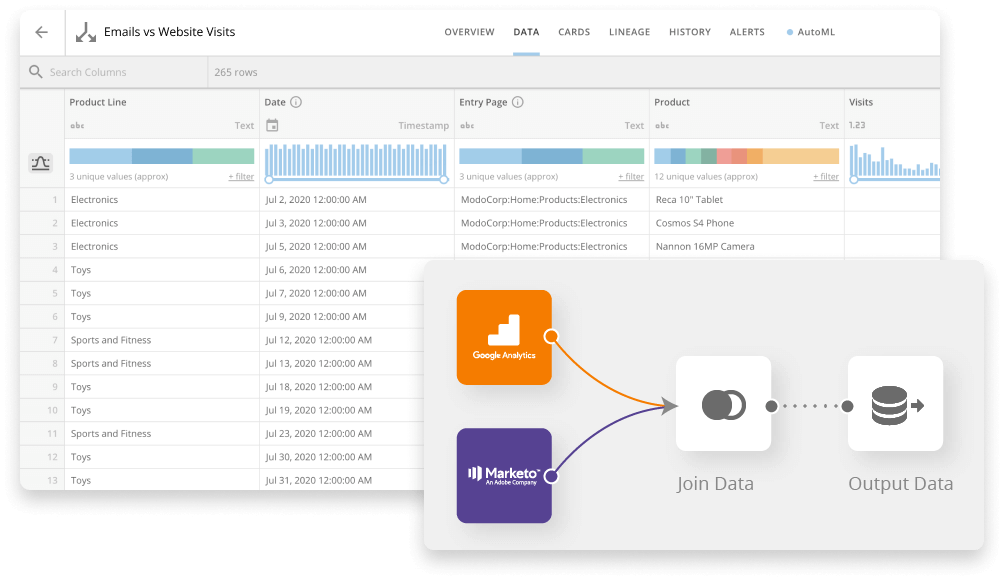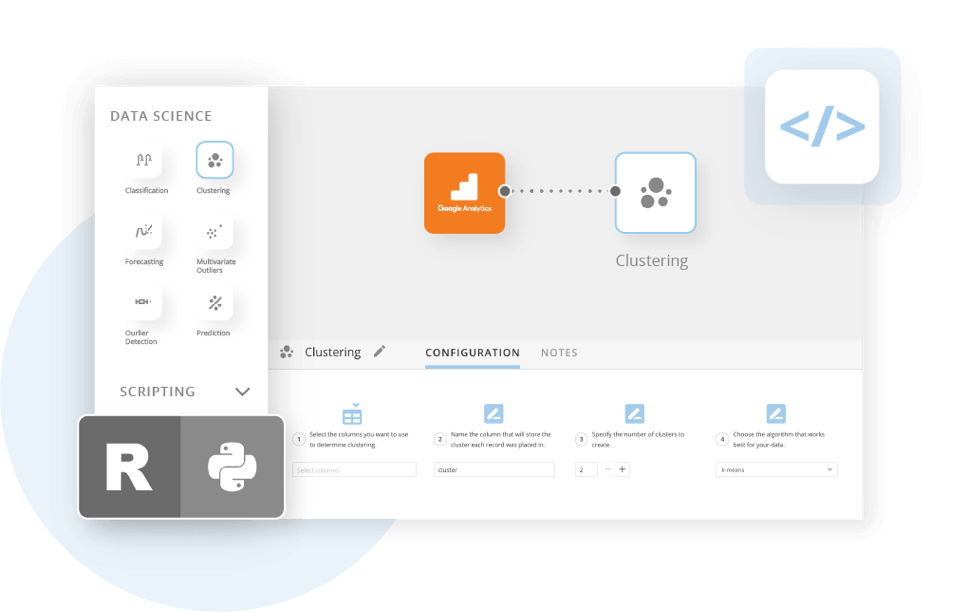ETL Tools
What are ETL tools?
Why are ETL tools important?
Benefits of ETL tools
How do ETL tools work?
What types of ETL tools are available today?
How do different industries use ETL tools?
How will ETL tools evolve in the future?
Try Domo for yourself.
Completely free.
What are ETL tools?
ETL stands for Extract, Transform, Load. ETL tools extract data from different sources, transform it by cleaning it and changing it into a standardized or more understandable format, and then load the data into a target destination. This destination source could be a solution like Domo or a data warehouse, data lake, or database.
ETL tools make raw data into actionable information that organizations use for better business intelligence.
Why are ETL tools important?
Business intelligence is impossible without data integration, and data integration is nearly impossible without ETL tools. ETL tools were first designed in the late 1980s and early 1990s to work with on-premise data storage infrastructure. But, in the age of cloud storage and cloud technologies, ETL tools are still important.
Benefits of ETL tools
Historical context
With ETL tools, organizations can bring together legacy data and new data coming in from many sources. The result is a deep historical context for the numbers in front of you. Your view of data is long-term, which increases the ability to make informed decisions.
One point of view
Bringing data sets together and standardizing the format provides a single view of data that eliminates delays and inefficiencies. With one point of view, it’s easier to visualize data sets and analyze results.
Automation
Without ETL tools, the alternative is hand-coded data migration. This process is time intensive and open to human error. ETL tools automate the process so that teams can devote their time to analysis and innovation instead. Automation means greater accuracy and better compliance with data regulations and standards.
Metadata collection
Knowing where a data set comes from can provide valuable insights as well. When an ETL tool extracts data, it also collects metadata that helps business intelligence tasks like business process modeling. Metadata is stored in its own repository so it can easily be queried, manipulated, and retrieved.
Self-service
Outside of breaking down silos, ETL tools give self-service capabilities to team members who typically wouldn’t have the background to dive into data analytics. This keeps more decision makers in the know so they can better direct business. Drag and drop interfaces replace custom coding for faster, more scalable solutions, which increases your return on investment (ROI).
How do ETL tools work?
ETL tools follow a three-step process, and it’s all in the name — extract, transform, load.
Extraction
It’s difficult to find a modern organization that only uses one source of data, and many organizations use multiple data analysis tools, too. The first step in the process is extracting data from its source. Sources include but certainly are not limited to:
- Sales and marketing applications
- Data storage platforms
- Analytics tools
- Data warehouses
- Mobile apps and devices
- On-premise data storage
- Cloud data storage
- Databases
- CRM systems
ETL tools gather raw data, structured and unstructured, into a single location and consolidate it.
Transformation
The second step in the ETL process applies an organization’s rules and regulations to the data to make it meet requirements and be easily accessible. The transformation process includes:
- Cleaning the data to resolve inconsistencies and missing values.
- Standardizing the data to a predetermined format.
- Excluding or discarding redundant data.
- Removing unusable data from the data set and flagging any anomalies.
- Organizing data by type.
This step is arguably the most important part of the ETL process because it improves the quality and integrity of the data an organization collects.
Loading
Last but not least, transformed data is loaded into a new destination. This could be a solution like Domo or a standard data warehouse. Depending on the ETL tool, data may be loaded in one large batch or at scheduled intervals.
A word on extract, load, transform (ELT) methodology
Extract, load, transform (ELT) tools have the same purpose as ETL tools but the process is slightly different. ELT loads data into the central repository immediately after extraction instead of waiting to transform it. This approach is becoming popular with the rise of cloud storage instead of on-premise solutions, but ELT is still a relatively new process and tools are still evolving. Some organizations need both ETL and ELT tools for gathering data.
What types of ETL tools are available today?
There are many different ETL tools on the market today. Some tools may work better for one organization than another. An ETL tool’s effectiveness depends on a variety of factors including data governance practices and an organization’s current data technology solutions. In general, most modern ETL tools fall into these broad categories:
Legacy ETL tools
These ETL tools are the most traditional in their approach. They provide the essential function of ETL for data integration but tend to be more difficult to scale, slower to deploy, and more code intensive with less automation than other tools on the market.
Open-source ETL tools
While legacy ETL tools typically work exclusively with structured data, open-source ETL tools can process data in a wider variety of structures and formats. They are also more flexible, scalable, and quicker to deploy.
Cloud-based ETL tools
Cloud-based ETL tools are the most agile option on the market. The nature of the cloud means data is more readily available and that tools can scale with increased flexibility and speed. As more data sources move to the cloud or become a hybrid of on-premise and cloud data, cloud-based ETL tools are becoming essential for data integration.
Real-time ETL tools
Even if an ETL tool is cloud-based, it may still be processing data in batches. Real-time ETL tools capture data constantly, delivering results and reports in — you guessed it — real time. With real-time ETL tools, organizations can query streaming data sources like social media searches or Internet of Things (IoT) sensors and provide immediate responses.
How do different industries use ETL tools?
Across industries, ETL tools can help manage data and offer more complete views of customers, transactions, and KPIs.
Retailers can combine customer information like name, location, and purchase history with transactional data like sales. Healthcare providers can bring together patient information, healthcare history, and ongoing insurance claims.
ETL tools can also consolidate data from different organizations like in the case of a business merger or between an organization and its partners or vendors.
Other common use cases for ETL include migrating current data stores to the cloud, incorporating machine learning and AI into an organization’s data strategy, and collecting customer data from multiple platforms to offer better personalization and deliver improved user experiences.
How will ETL tools evolve in the future?
ETL tools will continue to be essential as the volume of data organizations collect grows exponentially. IoT will contribute to this vast data collection with streaming data.
Organizations will rely more heavily on ETL tools as they prepare to deploy machine learning and AI processes that require extensive data stores.
ETL tools will continue to evolve and improve by focusing on ease of use. Domo’s magic ETL is one example. Traditional ETL processes require IT professionals to manage the technical aspects of data integration and analytics. Magic ETL is a drag and drop interface that eliminates the coding skills gap. Anyone can direct data and pull reports, which democratizes data analytics and reduces typical data bottlenecks.
RELATED RESOURCES
Guide
Domo Product Guide
Report
Cloud Data Integration for Analytics
Article




